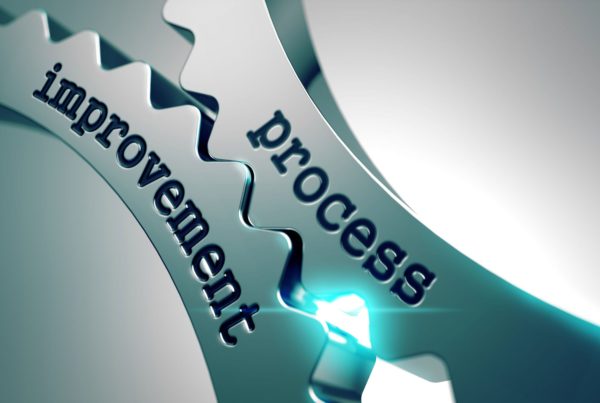Building on parts 1 and 2 of this KPI series, part 3 is about implementing metrics. Implementing metrics involves both technical pieces such as refining the metric criteria, as well as management pieces, such as preparing the team for changes.
Building Measurement Tools and Resources
The technical part of implementing metrics is straight forward: define the metric, the criteria, and the goals so that measuring the metric is universal and absolute. The goal in this step of the process is to ensure that everyone at all levels of the organization have a clear understanding of the expectations and the way that progress is measured.
Tools
Data Dictionary: A data dictionary is a document that establishes definitions, constraints and data requirements. It helps communicate results to the department and to leadership team in a consistent way. The data dictionary can be created in word or excel and would include these critical components:
| Component | Description |
| Activities list | Create an inventory of each and every process involved in all department. |
| Inputs and outputs | List all inputs and outputs of each activity. |
| Metrics and targets | Identify specific metrics and targets:
Be specific with what metrics measure. For example, if the metric is “process a document” specific if that means that the document is started or that the document is fully completed? For metrics related to the time spent for an activity, does include the time spent in between processes or just the time spent on the process itself? |
| Systems | Identify the specific systems that will be used to manage and record your metrics. Systems will include any reporting systems, internal systems, programs used to record metrics (such as Excel). |
| Data constraints | This will define how a data component will show up in the database. This will identify the specific types of figures and numbers that will be used in the accompanying database. ie. “time” is reported in hours and minutes in HH:MM format or “Tasks complete” is expressed as a whole number, “6”. |
| Responsibilities |
Specify who is responsible for collecting, measuring, and reporting data? Each component may be assigned to a different individual, or the same individual. Measurement owner responsibilities described in the following section.
|
| Frequency | Identify how often are results measured as well as how often are results reported. |
The data dictionary would be accompanied by the database that contains your KPI measurements. This database is created in excel and is organized to display time portions across the columns of the excel document, and the KPI results displayed horizontally. It includes targets or goals clearly displayed and then the actual and variance for each day. This is an example of what the database may look like:
| Metric | Target | Actual Day 1 | Variance Day 1 | Actual Day 2 | Variance Day 2 | Actual Day 3 | Variance Day 3 | Actual Day 4 |
| Service Measure 1 (%) | 100% | 96% | -4% | |||||
| Service Measure 2 (Qty) | 2 | 2 | 0 | |||||
| Quality Measure 1 (%) | 97% | 95% | -2% |
Once your metrics have been clearly defined and quantified, you can define the data collection criteria:
Collecting Data
Part of the data dictionary criteria is identifying the frequency of reporting on PPMs as well as who will be responsible for maintaining the data. In this step, you will identify data collection methods and assign responsibility.
The 3 main challenges with data collection are the following:
- Accuracy: data is recorded correctly and formulas in the PPM tracking database are correct
- Completeness: information is recorded as frequently as required. No pieces of data are missing.
- Timeliness: data is recorded within a time threshold in order to make timely decisions
Implementing an audit into your metric reporting process will help scrutinize data to ensure the information is correct, complete, and on time. An audit might be weekly or monthly and include a clear list of things to check in the database worksheet. The audit should include at minimum:
| Audit description: Audit is to be completed once per week by a supervisor or team lead and submitted on Friday before 12:00 pm by email to _______. | |
| Name of Auditor: | |
| Date of Audit: | |
List of specific audit items such as:
|
|
| Section to list variances or discrepancies: | |
| Follow up actions listed: | |
Data collection may be a manual effort on the outset and include obtaining results from several systems. However, it is possible to automate some of the data collection depending on the nature of the metric.
The challenges with data collection can be addressed by assigning a dedicated measurement owner for each KPI. A measurement owner is an individual within the department who is assigned the responsibility to collect, record, review, and report on a particular metric. They are not the individual who is solely responsible for achieving success of the metric; That is dependent on the entire team. However, they will be responsible for data collection and will be the champion for change, alerts, successes and innovation with regards to the metric. The measurement owner is also responsible for interpreting the KPI result into something meaningful for the department at a specified frequency (once per day, once per week, etc.).
To interpret the data, the measurement owner can interpret the following:
- What direction did the metric move over X time?
- How much did the metric move (as a percent)?
- What factors affected the results this reporting period?
- What could have been done to improve the results in the past reporting period?
Finally, the measurement owner is responsible for driving changes, innovation, and improvements to the process in order to meet or exceed KPI targets.
Implementation and Change Management
Implementing process performance metrics will require effective change management. This can be completed using the Procsi change management theory as a guiding framework.
Developing a change management plan requires the following key components: Preparation, communication and reinforcement. Each plan will need to be tailored to the unique needs of different departments.
| Check | Description |
| Prepare the department or team for change by answering the following questions: | |
|
|
| Before implementing changes, prepare for and execute the following tasks: | |
· Give the team time to digest the plans for change: Start communicating the changes early and provide enough information to prepare for and understand the potential changes. · Ensure the team understands why the changes are being implemented: Highlight the benefits and positive impacts to individuals/teams. This could include lowering the volume of backlogged projects and improving workflow. · Be specific about how the change might change individuals’ day-to-day: for example, will individuals and teams have to start recording new data for the KPIs? · Be transparent and forthright: address known challenges to set realistic expectations for the team. This also serves to invite the team to provide input on how to facilitate the process. · Create open two-way communication channels: Invite participation and feedback early on from individuals/teams. Schedule communication aligned with process changes and milestones
· Ensure staff have a thorough understanding of the new KPIs and are given direction on how to make positive changes within the department to meet or exceed targets. Team members will need to be taught ho to accurately and consistently report metrics/measurements · Ensure staff with new responsibilities, such as the measurement owners, feel confident to excel at these new tasks. · Be proactive and manage resistance early |
|
| Reinforce change | |
|
|
Be sure to evaluate what foreseeable challenges or resistance may occur through the change management process.
Common challenges you may encounter include:
- Concerns with increased workload or increased pressure to “produce”
- Anticipation of micro management since KPIs are data driven metrics
- Concerns that volume and speed will take precedence over quality and performance
Questions? Contact Us
If you want to learn how to instill a culture of Continuous Improvement within your organization contact us at Propel Solutions today. We specialize in creating high performing teams and have a proven track record of powerful results.
Propel Solutions
- 📍 789 W. Pender Street, Vancouver, BC, Canada
- 📞 604-346-5185








